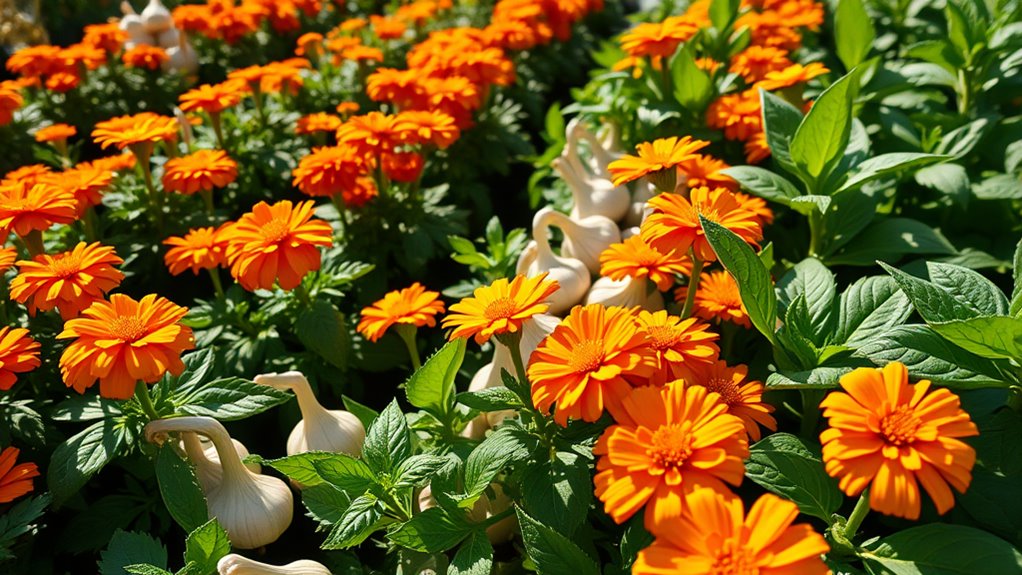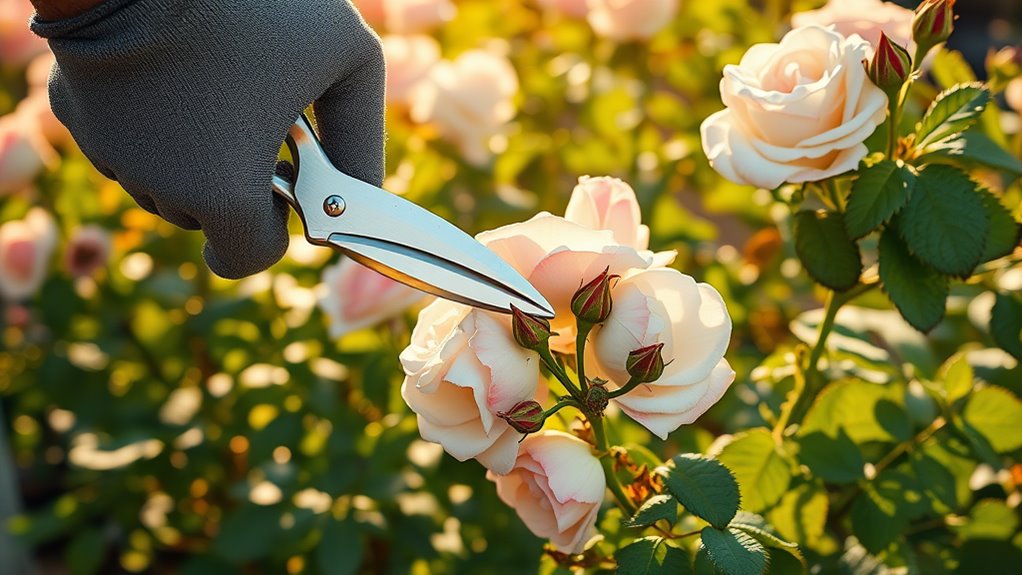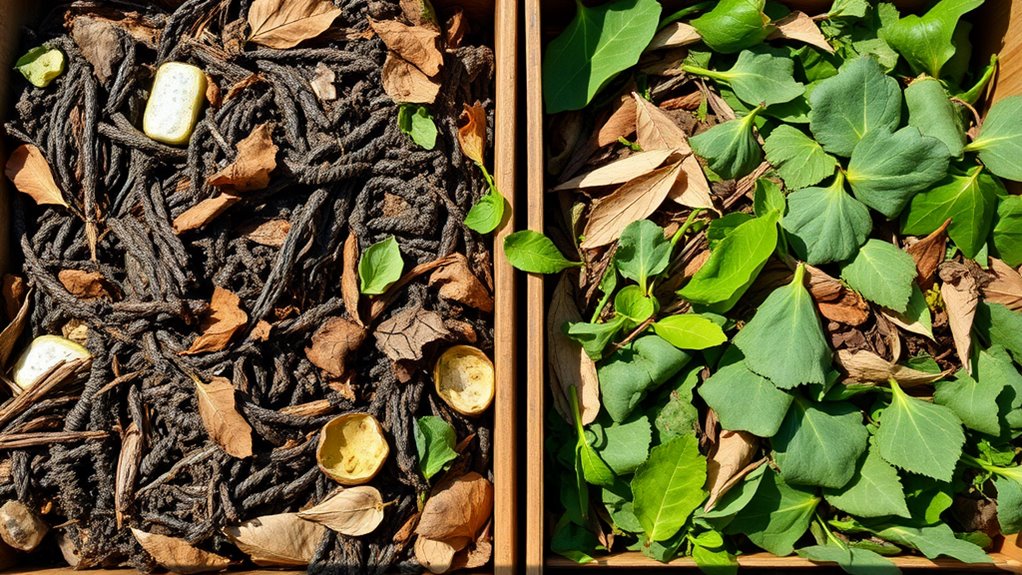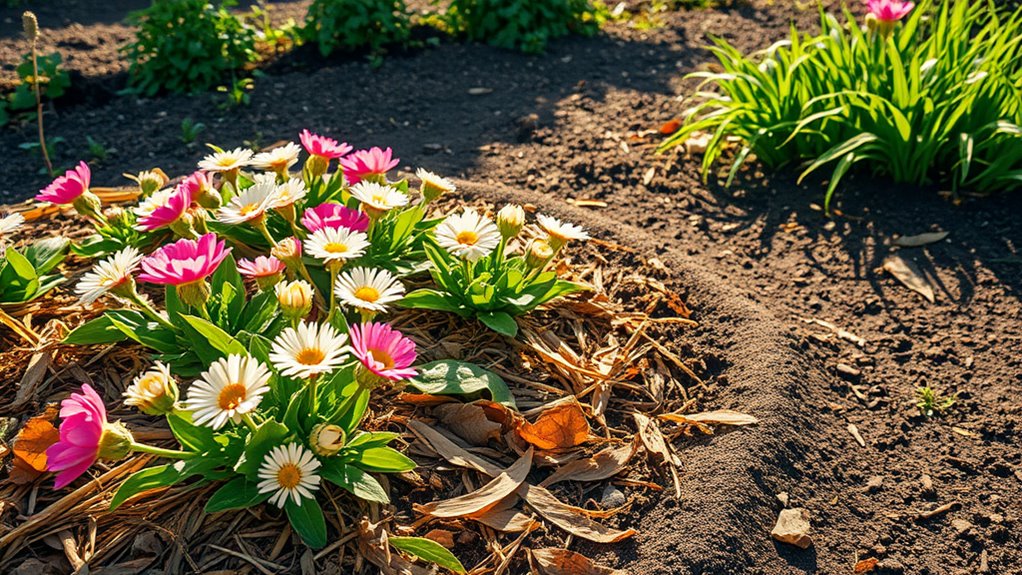How to Keep Pests Out Naturally With These Garden Staples
You’ll keep pests at bay naturally using garden staples like mint and basil, which repel ants and flies with their strong scents. Pair plants wisely, such as marigolds with tomatoes, to deter nematodes and boost defenses. Craft DIY barriers from aluminum foil or netting, and whip up homemade sprays from garlic or vinegar to disrupt invaders. Attract beneficial insects by planting nectar-rich flowers and building habitats, while routine inspections and crop rotation maintain balance. Dive deeper into these techniques for even greater garden success.
Key Takeaways
- Plant mint around garden areas to naturally repel ants and mosquitoes with its strong aroma.
- Use companion planting, like basil with tomatoes, to deter aphids and flies effectively.
- Create DIY barriers with aluminum foil to block crawling insects from reaching crops.
- Make a homemade garlic spray by steeping cloves in water to repel pests naturally.
- Attract beneficial insects by planting nectar-rich flowers near vulnerable plants for natural pest control.
Essential Herbs for Natural Pest Repellent
If you’re dealing with pests in your home or garden, essential herbs provide a simple, effective way to repel them naturally.
For garden pest prevention, you rely on herbs like mint, which wards off ants and mosquitoes with its strong aroma. Basil deters aphids and flies, while rosemary repels beetles and cabbage moths.
You crush or plant these herbs strategically around vulnerable areas to release their oils. Harvest fresh leaves for sprays or barriers, ensuring a chemical-free defense.
This method saves money and promotes healthier plants, making it a practical choice for every gardener. By incorporating these herbs, you contribute to a healthy garden ecosystem. Moreover, herbs like lavender can provide effective pest control for additional insect deterrence.
Companion Planting Techniques for Gardens
Building on your herb-based pest defenses, companion planting offers a smart strategy to boost garden health by strategically pairing plants that support each other. You’ll deter pests and enhance growth by placing repellent plants near vulnerable ones, like marigolds with tomatoes to ward off nematodes. This technique promotes biodiversity and natural balance in your garden. The scientific principles behind companion planting ensure that these pairings are effective and sustainable. Leveraging companion planting strategies can help increase your crop yields and foster even more thriving plant pairings this season.
| Companion Plant | Repellent Plant | Key Benefits |
|---|---|---|
| Tomatoes | Basil | Repels flies and improves flavor |
| Carrots | Onions | Deters carrot flies and boosts yield |
| Beans | Marigolds | Reduces nematodes and enhances soil health |
DIY Barriers Using Common Household Items
Beyond companion planting, safeguard your garden by crafting DIY barriers from everyday household items.
You’ll find these barriers simple to build and highly effective at blocking pests physically.
-
Aluminum foil barriers: Wrap foil around plant stems to prevent crawling insects like ants from reaching your crops.
-
Netting or screens: Drape fine mesh over vulnerable areas to keep flying pests, such as aphids, at bay without obstructing sunlight.
-
Cardboard collars: Cut and place rings around seedlings to stop soil-dwelling invaders like cutworms from attacking roots.
These techniques use what you’ve got on hand for reliable, natural defense.
Moreover, these barriers can be combined with unconventional remedies to provide even stronger protection against common garden pests.
These methods are part of natural DIY techniques that promote a pest-free garden without any additional costs.
Homemade Sprays From Kitchen Staples
You can whip up effective homemade sprays using kitchen staples like garlic and vinegar to naturally deter pests from your home.
Start with a simple garlic spray recipe that leverages its strong odor to repel insects quickly.
Then, try a vinegar pest solution that’s straightforward and safe for keeping common invaders at bay. Additionally, these sprays involve application methods that make them easy to use for maintaining garden health.
By incorporating these methods, you can achieve a healthy garden while relying on organic ingredients for pest control.
Garlic Spray Recipe
Garlic stands out as a potent, natural repellent for pests, offering a simple spray you can whip up from basic kitchen ingredients. It’s effective against common garden invaders and helps maintain a healthy, chemical-free space.
-
Gather ingredients: You’ll need 4-5 fresh garlic cloves, 1 quart of water, and 1 teaspoon of mild liquid soap for adhesion.
-
Prepare the mixture: Crush the garlic cloves, steep them in water overnight, then strain the liquid into a spray bottle.
-
Apply the spray: Shake well and mist your plants thoroughly, focusing on leaves and stems, every few days as needed.
This method keeps your garden thriving naturally.
Vinegar Pest Solution
Vinegar offers a versatile, natural alternative for repelling pests, drawing from everyday kitchen staples to create effective homemade sprays.
You mix equal parts white vinegar and water in a spray bottle, adding a few drops of dish soap to boost adhesion. This solution disrupts ants’, aphids’, and fruit flies’ sensory systems, making it ideal for garden use.
Spray directly on affected plants or entry points, but test on a small area first to avoid damage. Reapply every few days or after rain for consistent protection.
It’s safe, cost-effective, and easy to prepare at home.
Attracting Beneficial Insects to Your Plants
To keep pests at bay naturally, you’ll want to attract beneficial insects that prey on them, so start by incorporating simple strategies into your garden.
Plant nectar flowers and add pollen sources to draw in these helpful bugs, while you build insect shelters for added protection.
This approach not only boosts your plant’s defenses but also creates a balanced ecosystem right in your backyard. Moreover, addressing top five pests will help ensure a more targeted and effective pest management plan in your garden.
Additionally, these practices can be combined with natural pest control techniques to further safeguard your garden’s health.
Plant Nectar Flowers
One effective way to boost your garden’s natural defenses is by planting nectar-rich flowers, which draw in beneficial insects like ladybugs and hoverflies.
These insects act as natural pest controllers, feasting on aphids and other nuisances while pollinating your plants. You’ll create a vibrant, self-sustaining ecosystem.
To get started effectively:
-
Choose diverse flowers: Select varieties like marigolds, alyssum, and cosmos to attract a range of beneficial insects for broader pest control.
-
Plant strategically: Position them near vulnerable crops to maximize insect visits and enhance protection without extra effort.
-
Maintain for longevity: Regularly water and deadhead blooms to ensure a steady nectar supply, keeping your allies coming back.
This method keeps pests at bay naturally.
Build Insect Shelters
Building insect shelters in your garden draws beneficial insects like ladybugs and lacewings, turning them into your first line of defense against pests. This technique is cost-effective and simple, using everyday materials like wood, stones, and leaves to create safe habitats. You’ll boost natural pest control by placing shelters in sunny, sheltered spots, allowing insects to thrive and reproduce. Start with basic designs: a bug hotel from drilled logs, or a leaf pile for overwintering. Here’s a table highlighting shelters and their key attractions:
| Shelter Type | Attracted Insects |
|---|---|
| Bug Hotel | Ladybugs, Lacewings |
| Leaf Pile | Ground Beetles |
| Stacked Stones | Spiders |
| Tall Grasses | Parasitoid Wasps |
| Dead Wood Pile | Earwigs |
Add Pollen Sources
Beyond building shelters, you attract even more beneficial insects by adding pollen-rich plants to your garden.
These additions create a thriving ecosystem where pollinators like bees and ladybugs naturally combat pests.
To get started effectively:
-
Choose diverse plants****: Select easy-to-grow options like sunflowers, marigolds, and alyssum; they provide ample pollen and bloom reliably.
-
Integrate strategically: Place them near vulnerable crops to draw insects directly where you need pest control most.
-
Maintain regularly: Water and prune to ensure continuous blooming, keeping beneficial insects coming back all season.
Routine Practices for Long-Term Pest Prevention
While occasional cleanups help, you’ll prevent pests from returning by integrating simple, natural routines into your daily life. Additionally, utilize natural pest sprays that have demonstrated effectiveness in managing garden pests based on real experiences.
Make daily garden inspections a habit to spot issues early—check leaves for eggs or damage and remove them promptly.
Rotate crops annually to disrupt pest cycles, and maintain soil health with organic mulches that suppress weeds and retain moisture.
Encourage beneficial insects by planting diverse flowers, and water at the base of plants to avoid wet foliage that invites fungi.
These practices build resilience, keeping your garden thriving without chemicals—consistency is key for lasting results.
Incorporate eco-friendly weed control techniques, such as using natural mulches, to minimize weed competition and support overall garden health.





